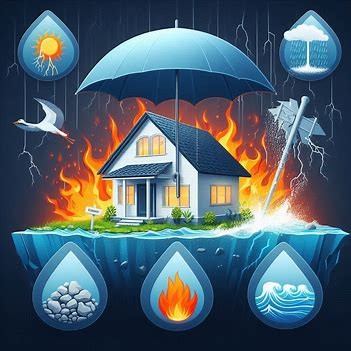Hazard insurance is a crucial component of homeownership in the USA, offering protection against various risks that could damage or destroy a home. Often misunderstood or confused with homeowners insurance, hazard insurance specifically covers the structure of the home and its contents from certain perils. Understanding its importance, especially for those with mortgages, is key to ensuring proper protection for one of the most significant investments many people will ever make. This article will delve into the nuances of hazard insurance, its coverage, costs, and the factors homeowners should consider when choosing a policy.
Table of Contents
ToggleWhat is Hazard Insurance
Hazard insurance is a vital part of a standard homeowners insurance policy, designed to safeguard the physical structure of a home against damages caused by specific perils such as fire, wind, or theft. While hazard insurance is sometimes used interchangeably with homeowners insurance, they are not the same. Homeowners insurance encompasses broader coverage, including liability protection and additional living expenses in case the home becomes uninhabitable, while hazard insurance focuses solely on protecting the property from physical damage.
Common terminology within hazard insurance includes terms like “dwelling coverage,” which refers to the part of the policy that covers the home itself, and “perils,” which are the specific risks or events that the insurance policy protects against. Understanding these terms is essential for homeowners when reviewing their policies or discussing coverage options with their insurance providers.
Coverage Provided by Hazard Insurance
Hazard insurance typically covers a range of perils that could affect the integrity of a home. Common hazards include:
- Fire and smoke: Protection against damage caused by accidental fires or smoke, which can cause significant structural damage.
- Wind and hail: Coverage for damage resulting from severe weather conditions such as hurricanes or thunderstorms.
- Theft and vandalism: Insurance that compensates for losses or damages caused by burglary or intentional destruction of property.
- Water damage (from household appliances): Covers damage from malfunctioning or leaking appliances, such as washing machines or dishwashers.
It’s important to note that hazard insurance has limitations. For instance, standard policies often exclude coverage for natural disasters like earthquakes and floods, which typically require separate policies. Homeowners must review their individual policies to understand these exclusions and consider additional coverage if they live in high-risk areas for these events.
The Role of Hazard Insurance for Homeowners
For homeowners, hazard insurance is not just an optional safeguard but often a requirement imposed by mortgage lenders. Lenders require hazard insurance to protect their financial interest in the property, ensuring that the home can be repaired or rebuilt if it is damaged by a covered peril.
This insurance plays a crucial role in protecting homeowners from financial loss due to property damage. Without it, homeowners could face significant out-of-pocket expenses to repair or replace their homes in the event of a disaster. This is particularly important for first-time homebuyers, who might not fully understand the risks associated with homeownership or the potential costs of property damage.
Types of Coverage in Hazard Insurance Policies
Hazard insurance policies typically include several types of coverage:
- Dwelling coverage: This protects the physical structure of the home, including the walls, roof, and foundation, against covered perils.
- Other structures coverage: This extends protection to additional structures on the property, such as garages, fences, or sheds.
- Personal property coverage: This covers personal belongings inside the home, such as furniture, electronics, and clothing, from damage or theft.
Each of these coverages plays a vital role in ensuring comprehensive protection for homeowners, safeguarding not only the structure of the home but also the valuable possessions within it.
Costs Associated with Hazard Insurance
The cost of hazard insurance can vary widely based on several factors:
- Location of the property: Homes in areas prone to natural disasters like hurricanes, wildfires, or floods may face higher insurance premiums.
- Type of coverage selected: More extensive coverage or higher policy limits will generally increase the cost of insurance.
- Deductibles and limits: Choosing a higher deductible can lower the premium but will increase out-of-pocket costs in the event of a claim.
On average, homeowners in the USA can expect to pay between $600 and $1,200 annually for hazard insurance, although this can vary significantly depending on the region and specific circumstances of the property.
How to Choose the Right Hazard Insurance Policy
Selecting the right hazard insurance policy requires careful consideration of personal needs and risks. Homeowners should:
- Assess personal needs and risks: Evaluate the specific risks associated with the property’s location and the home’s value.
- Compare different policies and providers: Shop around to find the best coverage and rates, considering both the reputation of the insurance company and the specifics of the policy.
- Understand policy terms and conditions: It’s crucial to thoroughly review the terms and conditions of the policy, including coverage limits, exclusions, and deductibles.
Additional Coverage Options
In addition to standard hazard insurance, homeowners may need to consider additional coverage options:
- Separate policies for specific risks: For risks not covered by standard hazard insurance, such as floods or earthquakes, homeowners should consider purchasing separate policies.
- Endorsements and riders: These are additions to a policy that can enhance coverage, such as adding coverage for valuable personal property or increasing limits on certain types of claims.
- Adapting coverage as circumstances change: As homeowners’ needs and risks evolve, it’s important to review and adjust their insurance coverage accordingly.
The Future of Hazard Insurance
The landscape of hazard insurance is likely to change as climate change increases the frequency and severity of natural disasters. Homeowners need to stay informed about these changes and be prepared to adapt their insurance coverage to meet new risks. Trends in the insurance industry, such as the integration of technology for risk assessment and claims processing, may also influence the future of hazard coverage.
Conclusion
Hazard insurance is an essential part of protecting a home, offering crucial coverage against a range of perils. Understanding its nuances, including what is covered, costs, and how to choose the right policy, is vital for every homeowner. As risks evolve, so too must the approach to hazard insurance, ensuring that coverage remains adequate in the face of new challenges.





